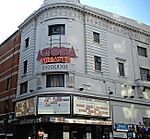Tottenham Court Road station
Buildings and structures on Tottenham Court RoadCentral line (London Underground) stationsEngvarB from August 2017Former Central London Railway stationsFormer Charing Cross, Euston and Hampstead Railway stations ... and 17 more
London Underground Night Tube stationsLondon Underground stations located undergroundLondon stations without latest usage statistics 1415London stations without latest usage statistics 1516London stations without latest usage statistics 1617London stations without latest usage statistics 1718London stations without latest usage statistics 1819London stations without latest usage statistics 1920London stations without latest usage statistics 2021Northern line stationsProposed Chelsea-Hackney Line stationsRail transport stations in London fare zone 1Railway stations in Great Britain opened in 1900Railway stations in Great Britain opened in 1907Railway stations located underground in the United KingdomRailway stations served by the Elizabeth lineTube stations in the City of Westminster

Tottenham Court Road is a London Underground and Elizabeth line station in St Giles in the West End of London. The station is served by the Central line, the Elizabeth line and the Charing Cross branch of the Northern line. The station is located at St Giles Circus, the junction of Tottenham Court Road, Oxford Street, New Oxford Street and Charing Cross Road and is in Travelcard Zone 1, with a second entrance at Dean Street.
Excerpt from the Wikipedia article Tottenham Court Road station (License: CC BY-SA 3.0, Authors, Images).Tottenham Court Road station
Oxford Street, City of Westminster Bloomsbury
Geographical coordinates (GPS) Address Nearby Places Show on map
Geographical coordinates (GPS)
| Latitude | Longitude |
|---|---|
| N 51.5162 ° | E -0.1309 ° |
Address
Oxford Street 17
W1D 1AP City of Westminster, Bloomsbury
England, United Kingdom
Open on Google Maps






